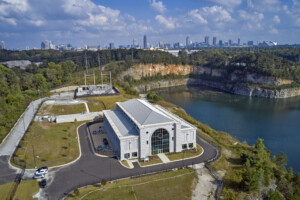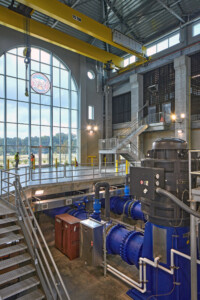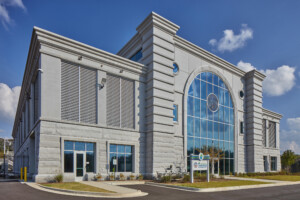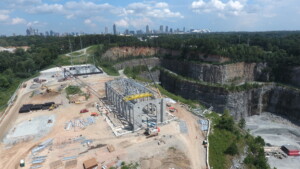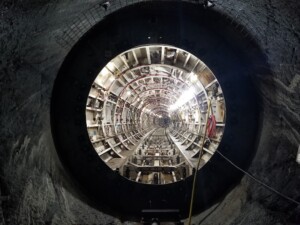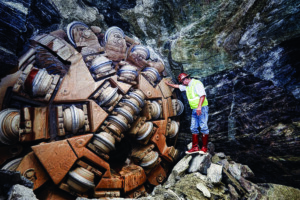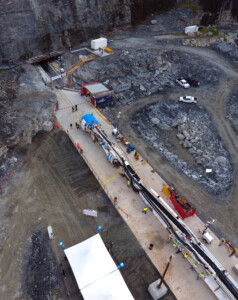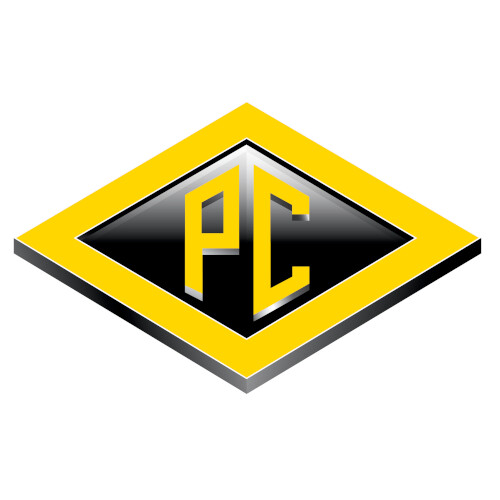Challenge
The City of Atlanta faced a crippling issue with only a three-day reserve of emergency raw water and increasing drought conditions and emergencies in the Atlanta area. If the city’s water supply was ever compromised, it could lose upwards of $250 million per day in economic activity. To ensure that residents and businesses would have consistent access to clean, safe drinking water, the City of Atlanta undertook this $321 million construction management at-risk (CMAR) project. The work involved converting a 400-foot-deep rock quarry into a 2.4-billion-gallon water storage facility, then connecting it to two water treatment plants and the raw water supply source miles away at the Chattahoochee River. New infrastructure including pumping stations, deep shafts, adits, and miles of newly constructed underground tunnel were also included.
Approach
The City of Atlanta opted to use the CMAR delivery method because of the magnitude of the project scope and complexity and the need for cost and schedule certainty and expedited construction completion. As with most large municipal and governmental projects, a public solicitation was conducted to select the construction manager. The City’s evaluation process ranked teams on a combination of qualifications and experience, approach to the project, and a fee proposal. PC Construction’s team was shortlisted and eventually selected to serve as the project’s construction manager at-risk (CMAR) and allowed to self-perform work up to 10% of the overall construction cost.
The project scope was initially divided into two separate phases planned to be built under two tunnel contracts with the Phase 1 tunnel starting at the Bellwood Quarry and ending at Hemphill WTP (approximately one mile upstream of the quarry) and a future second phase continuing to the Chattahoochee River (approximately four miles upstream of the Hemphill WTP). After PC Construction’s team was selected for the project, a baseline construction cost estimate and schedule were developed, which was the project’s first true construction cost-estimating effort. During this stage, a major budget and schedule issue was uncovered. As a result, the two phases were combined into one to reduce significant cost and schedule. All stakeholders worked together to redesign, recoordinate, and reprioritize the work to meet budget and schedule. This combined approach shaved several years and millions of dollars from the program schedule and cost.
During the preconstruction phase, the team worked closely with the owner to develop eight component guaranteed maximum prices (CGMPs) to allow procurement and construction to begin on the longest-duration activities, such as enabling work and the underground tunnel and shaft work. As procurement and early work began, design and preconstruction services continued simultaneously. Throughout this effort, the team was located together within one massive field office complex. This true co-location experience led to exceptional teamwork and the ability to effectively manage challenges.
This project took an innovative approach from the earliest stages of design and construction. Underutilized assets, such as the former quarry, were transformed into a storage reservoir for billions of gallons of water. Aging infrastructure, including 130-year-old water mains, were replaced with a single underground tunnel to convey and store water.
To date, the vast majority of tunnels have been used for transportation and, on the wastewater and stormwater side, to prevent CSOs and flooding. Water tunnels are a relatively new application, and this project is quite distinctive in its concept. Perhaps just as unique is the delivery method—a municipal waterworks project delivered via CMAR. This delivery method promoted tremendous teamwork between the owner, engineer, and contractor and ensured the entire team was always working toward the unified best interests of the project.
This was an incredibly challenging project for its scope of work. Work was spread across four distinct sites connected via five miles of tunnel located hundreds of feet below street level. The largest project component—five miles of 12.5-footdiameter tunnel—was successfully mined in hard rock conditions with the PC CMAR team working closely with subcontractor Atkinson Construction, a wholly owned subsidiary of Clark Construction Group. Tremendous efforts on safety, training, and coordination kept the tunnel operation working multiple shifts around the clock for 48 months. And when faced with unforeseen hazardous groundwater intrusion during tunneling, the team rallied together to find a solution in a remarkable timeframe.
The final stretch of the project, from March through October 2020, faced incredible challenges and constant pressure from COVID-19. Due to travel restrictions, it was impossible for the German engineering team to come to the US, as required, to install the specialty 300-foot-deep Andritz submersible pumps. The PC team proposed a plan to self-perform this installation. Utilizing the latest virtual and remote technologies, the PC team successfully installed the equipment under the watchful eye of the German team from over 4,000 miles away.
Results
This incredibly complex project was completed on time and $5 million under the budgeted and approved CGMPs. It has become a model for municipalities around the world for both its innovative scope of work and its implementation of the CMAR delivery method to provide best value while building a challenging public works project on time and within budget. The Water Supply Program provides Atlanta with a water contingency plan for the first time in its history and increases its raw water reserve from a three-day supply to more than 30 days.
The project created 6,072 jobs and led to significant private investments in new residential and commercial property developments in areas surrounding the Quarry Reservoir and the newly developed 128-acre Westside Park.
Upon completion, the project received a total of eight global, national, and regional awards, as well as three sustainability certifications. This recognition includes the following:
- Construction Risk Partners Build America Award
- CMAA Project Achievement Award
- Global Water Intelligence Highly Commended Award
- ENR Southeast Best Project
- ENR Southeast Project of the Year
- ENR Global Best Projects Award of Merit
- ENR Best of the Best – Top Water/Wastewater Project in the Country
- Underground Construction Association Project of the Year Award
- LEED Gold & Silver Pump Stations
- Envision Silver
Other WCDA members involved: Black & Veatch (owner advisor/structural engineer/MEP engineer); Stantec (lead designer)
“The five-year-long multi-site construction project is the most logistically challenging project executed by the city’s Department of Watershed Management to date. The results put our city in a position of strength and allow for a significant expansion of our water reserve. The project has not only transformed our community’s water infrastructure, but also how we view the ultimate success of our utility construction projects.”
— Ade Abon, PE, Senior Watershed Director / Water Supply Program Director, City of Atlanta

